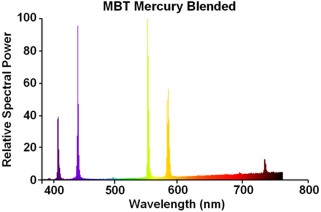
|
Mazda MBT/V High Pressure Mercury Blended |

The high pressure quartz MB lamps which superseded the MA glass styles had marginally better colour properties on account of the higher pressure discharge. The light of these lamps was more of a blueish-white colour, but still with only 2% red ratio.
Before the advent of phosphors and other techniques for colour correction, lamps were fabricated with a tungsten filament inside the outer envelope, the continuous emission of the filament bringing the red ratio to about 8%, a great improvement (but still far from the 25% of filament lamps). A further advantage was that by connecting the filament in series with the arc tube, the positive characteristic of the former acted as a ballast to control the current to the arc tube and no auxiliary control gear was required.
Philips was first to propose such a design, and following the release of the so-called mercury blended lamp in 1937, Siemens was the first UK firm to commence production of this lamp. Siemens later developed a unique series of self-ballasted MAT lamps in the higher wattages. The MBT style illustrated here was made by Siemens for most of the major British brands, and this earliest design employs a completely hand-made arc tube. The outer bulb is in the 'pearl' finish to ensure thorough mixing of the light from each component.
| Manufacturer: | Siemens Edison Swan Ltd. | |
| Lamp Power: | 200 Watts | |
| Lamp Current: | 0.8 Amps | |
| Lamp Voltage: | 200 Volts | |
| Cap: | E27s/27 (Brass) | |
| Bulb Finish: | Pearl | |
| Bulb Type: | PS-90 | Soda-Lime |
| Overall Length: | 178 ± 5.5 mm | |
| Light Centre Length: | Arc : 125 mm | Filament : 133 mm |
| Electrodes: | C-6 open coil containing a coiled thoria pellet | |
| Inner / Outer Atmosphere: | Inner : Argon | Outer : Nitrogen |
| Luminous Flux: | 3,400 lm (100 hrs) | 2800 lm (average thro' life) |
| Luminous Efficacy: | 17 lm/W (100 hrs) | 14 lm/W (average thro' life) |
| Colour Temperature & CRI: | CCT: 5000K | CRI: Ra 40 (9% Red) |
| Chromaticity Co-ordinates: | CCx: 0.349 | CCy: 0.380 |
| Burning Position: | Universal | |
| Rated Life: | 6,000 hours (to 50% survival) | |
| Warm Up / Re-strike Time: | 3 minutes | 5 minutes |
| Factory: | Strand Road, Preston | England |
| Date of Manufacture: | Circa 1945 (lamp is not marked) | |
| Original / Present Value: | £2 10s 0d (1945) | £66.77 (2001) |
